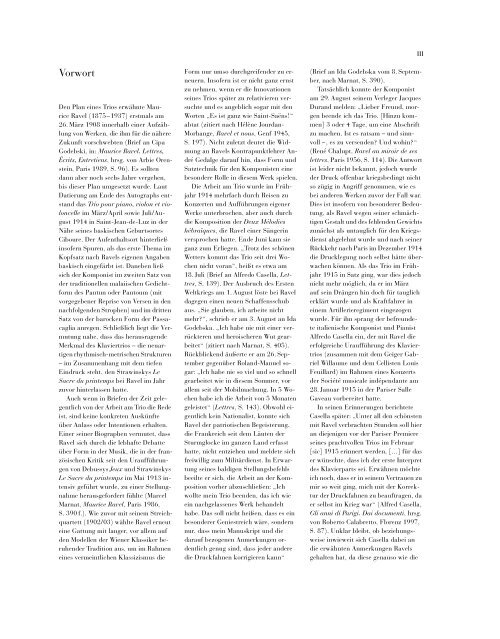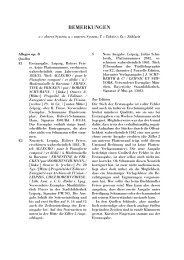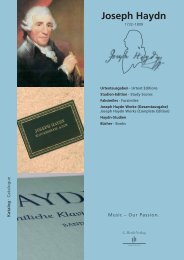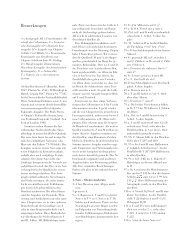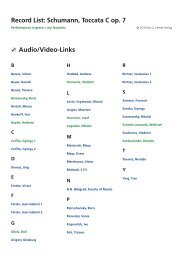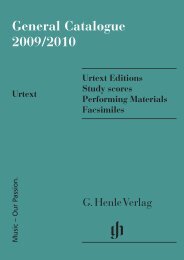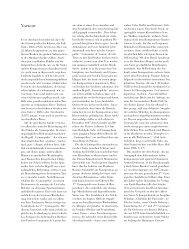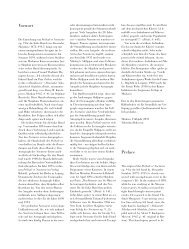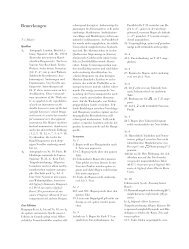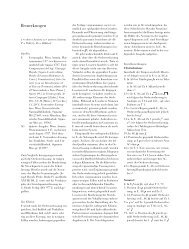Vorwort - Henle Verlag
Vorwort - Henle Verlag
Vorwort - Henle Verlag
You also want an ePaper? Increase the reach of your titles
YUMPU automatically turns print PDFs into web optimized ePapers that Google loves.
<strong>Vorwort</strong><br />
Den Plan eines Trios erwähnte Maurice<br />
Ravel (1875–1937) erstmals am<br />
26. März 1908 innerhalb einer Aufzählung<br />
von Werken, die ihm für die nähere<br />
Zukunft vorschwebten (Brief an Cipa<br />
Godebski, in: Maurice Ravel. Lettres,<br />
Écrits, Entretiens, hrsg. von Arbie Orenstein,<br />
Paris 1989, S. 96). Es sollten<br />
dann aber noch sechs Jahre vergehen,<br />
bis dieser Plan umgesetzt wurde. Laut<br />
Datierung am Ende des Autographs entstand<br />
das Trio pour piano, violon et violoncelle<br />
im März/April sowie Juli/August<br />
1914 in Saint-Jean-de-Luz in der<br />
Nähe seines baskischen Geburtsortes<br />
Ciboure. Der Aufenthaltsort hinterließ<br />
insofern Spuren, als das erste Thema im<br />
Kopfsatz nach Ravels eigenen Angaben<br />
baskisch eingefärbt ist. Daneben ließ<br />
sich der Komponist im zweiten Satz von<br />
der traditionellen malaiischen Gedichtform<br />
des Pantun oder Pantoum (mit<br />
vorgegebener Reprise von Versen in den<br />
nachfolgenden Strophen) und im dritten<br />
Satz von der barocken Form der Passacaglia<br />
anregen. Schließlich liegt die Vermutung<br />
nahe, dass das herausragende<br />
Merkmal des Klaviertrios – die neuartigen<br />
rhythmisch-metrischen Strukturen<br />
– im Zusammenhang mit dem tiefen<br />
Eindruck steht, den Strawinskys Le<br />
Sacre du printemps bei Ravel im Jahr<br />
zuvor hinterlassen hatte.<br />
Auch wenn in Briefen der Zeit gelegentlich<br />
von der Arbeit am Trio die Rede<br />
ist, sind keine konkreten Auskünfte<br />
über Anlass oder Intentionen erhalten.<br />
Einer seiner Biographen vermutet, dass<br />
Ravel sich durch die lebhafte Debatte<br />
über Form in der Musik, die in der französischen<br />
Kritik seit den Uraufführungen<br />
von Debussys Jeux und Strawinskys<br />
Le Sacre du printemps im Mai 1913 intensiv<br />
geführt wurde, zu einer Stellungnahme<br />
herausgefordert fühlte (Marcel<br />
Marnat, Maurice Ravel, Paris 1986,<br />
S. 390 f.). Wie zuvor mit seinem Streichquartett<br />
(1902/03) wählte Ravel erneut<br />
eine Gattung mit langer, vor allem auf<br />
den Modellen der Wiener Klassiker beruhender<br />
Tradition aus, um im Rahmen<br />
eines vermeintlichen Klassizismus die<br />
Form nur umso durchgreifender zu erneuern.<br />
Insofern ist er nicht ganz ernst<br />
zu nehmen, wenn er die Innovationen<br />
seines Trios später zu relativieren versuchte<br />
und es angeblich sogar mit den<br />
Worten „Es ist ganz wie Saint-Saëns!“<br />
abtat (zitiert nach Hélène Jourdan-<br />
Morhange, Ravel et nous, Genf 1945,<br />
S. 197). Nicht zuletzt deutet die Widmung<br />
an Ravels Kontrapunktlehrer André<br />
Gedalge darauf hin, dass Form und<br />
Satztechnik für den Komponisten eine<br />
besondere Rolle in diesem Werk spielen.<br />
Die Arbeit am Trio wurde im Frühjahr<br />
1914 mehrfach durch Reisen zu<br />
Konzerten und Aufführungen eigener<br />
Werke unterbrochen, aber auch durch<br />
die Komposition der Deux Mélodies<br />
hébraïques, die Ravel einer Sängerin<br />
versprochen hatte. Ende Juni kam sie<br />
ganz zum Erliegen. „Trotz des schönen<br />
Wetters kommt das Trio seit drei Wochen<br />
nicht voran“, heißt es etwa am<br />
18. Juli (Brief an Alfredo Casella, Lettres,<br />
S. 139). Der Ausbruch des Ersten<br />
Weltkriegs am 1. August löste bei Ravel<br />
dagegen einen neuen Schaffensschub<br />
aus. „Sie glauben, ich arbeite nicht<br />
mehr?“, schrieb er am 3. August an Ida<br />
Godebska. „Ich habe nie mit einer verrückteren<br />
und heroischeren Wut gearbeitet“<br />
(zitiert nach Marnat, S. 405).<br />
Rückblickend äußerte er am 26. September<br />
gegenüber Roland-Manuel sogar:<br />
„Ich habe nie so viel und so schnell<br />
gearbeitet wie in diesem Sommer, vor<br />
allem seit der Mobilmachung. In 5 Wochen<br />
habe ich die Arbeit von 5 Monaten<br />
geleistet“ (Lettres, S. 143). Obwohl eigentlich<br />
kein Nationalist, konnte sich<br />
Ravel der patriotischen Begeisterung,<br />
die Frankreich seit dem Läuten der<br />
Sturmglocke im ganzen Land erfasst<br />
hatte, nicht entziehen und meldete sich<br />
freiwillig zum Militärdienst. In Erwartung<br />
seines baldigen Stellungsbefehls<br />
beeilte er sich, die Arbeit an der Komposition<br />
vorher abzuschließen: „Ich<br />
wollte mein Trio beenden, das ich wie<br />
ein nachgelassenes Werk behandelt<br />
habe. Das soll nicht heißen, dass es ein<br />
besonderer Geniestreich wäre, sondern<br />
nur, dass mein Manuskript und die<br />
darauf bezogenen Anmerkungen ordentlich<br />
genug sind, dass jeder andere<br />
die Druckfahnen korrigieren kann“<br />
III<br />
(Brief an Ida Godebska vom 8. September,<br />
nach Marnat, S. 390).<br />
Tatsächlich konnte der Komponist<br />
am 29. August seinem Verleger Jacques<br />
Durand melden: „Lieber Freund, morgen<br />
beende ich das Trio. [Hinzu kommen]<br />
3 oder 4 Tage, um eine Abschrift<br />
zu machen. Ist es ratsam – und sinnvoll<br />
–, es zu versenden? Und wohin?“<br />
(René Chalupt, Ravel au miroir de ses<br />
lettres, Paris 1956, S. 114). Die Antwort<br />
ist leider nicht bekannt, jedoch wurde<br />
der Druck offenbar kriegsbedingt nicht<br />
so zügig in Angriff genommen, wie es<br />
bei anderen Werken zuvor der Fall war.<br />
Dies ist insofern von besonderer Bedeutung,<br />
als Ravel wegen seiner schmächtigen<br />
Gestalt und des fehlenden Gewichts<br />
zunächst als untauglich für den Kriegsdienst<br />
abgelehnt wurde und nach seiner<br />
Rückkehr nach Paris im Dezember 1914<br />
die Drucklegung noch selbst hätte überwachen<br />
können. Als das Trio im Frühjahr<br />
1915 in Satz ging, war dies jedoch<br />
nicht mehr möglich, da er im März<br />
auf sein Drängen hin doch für tauglich<br />
erklärt wurde und als Kraftfahrer in<br />
einem Artillerieregiment eingezogen<br />
wurde. Für ihn sprang der befreundete<br />
italienische Komponist und Pianist<br />
Alfredo Casella ein, der mit Ravel die<br />
erfolgreiche Uraufführung des Klaviertrios<br />
(zusammen mit dem Geiger Gabriel<br />
Willaume und dem Cellisten Louis<br />
Feuillard) im Rahmen eines Konzerts<br />
der Société musicale indépendante am<br />
28. Januar 1915 in der Pariser Salle<br />
Gaveau vorbereitet hatte.<br />
In seinen Erinnerungen berichtete<br />
Casella später: „Unter all den schönsten<br />
mit Ravel verbrachten Stunden soll hier<br />
an diejenigen vor der Pariser Premiere<br />
seines prachtvollen Trios im Februar<br />
[sic] 1915 erinnert werden, […] für das<br />
er wünschte, dass ich der erste Interpret<br />
des Klavierparts sei. Erwähnen möchte<br />
ich noch, dass er in seinem Vertrauen zu<br />
mir so weit ging, mich mit der Korrektur<br />
der Druckfahnen zu beauftragen, da<br />
er selbst im Krieg war“ (Alfred Casella,<br />
Gli anni di Parigi. Dai documenti, hrsg.<br />
von Roberto Calabretto, Florenz 1997,<br />
S. 87). Unklar bleibt, ob beziehungsweise<br />
inwieweit sich Casella dabei an<br />
die erwähnten Anmerkungen Ravels<br />
gehalten hat, da diese genauso wie die
IV<br />
Druckfahnen verschollen sind (zur<br />
Quellenlage und -bewertung vgl. die Bemerkungen<br />
am Ende der vorliegenden<br />
Ausgabe). Laut Druckbuch des <strong>Verlag</strong>s<br />
Durand kam das Klaviertrio am 12. Juni<br />
1915 heraus. Das Erscheinen noch im<br />
Jahr der Erstaufführung wird durch<br />
eine im November 1915 rückblickend<br />
veröffentlichte Kritik von Jean Marnold<br />
bestätigt, in der die Originalität des<br />
Trios mit zeitbedingten patriotischen<br />
Untertönen herausgehoben wird: „Der<br />
<strong>Verlag</strong> Durand et C ie hat inzwischen<br />
[seit der Uraufführung] das Trio von<br />
Maurice Ravel veröffentlicht. Es gibt<br />
nicht viel in der Musik, mit dem es verglichen<br />
werden könnte. […] Der Komponist<br />
liegt, mit größerem Format, ganz<br />
auf der Linie unseres sanften und tiefsinnigen<br />
Couperin. Kein Pathos, kein<br />
abstrakter Intellektualismus findet sich<br />
in dieser reinen Musik, deren impulsive<br />
Beherrschung, deren Leichtigkeit und<br />
deren beschwingter Atem auch von Mozart<br />
nicht übertroffen wurden. […] Ob<br />
Satztechnik, Harmonie, Polyphonie,<br />
Rhythmus oder Inspiration, alles ist<br />
neu, persönlich, vollkommen originell –<br />
und einfach, von dieser uns angeborenen<br />
Einfachheit, die unser Geheimnis ist<br />
und die die Perfektion unserer Meisterwerke<br />
ausmacht“ (Jean Marnold, Le cas<br />
Wagner. La musique pendant la guerre,<br />
Paris 1918, S. 71 f.).<br />
Neben den Anmerkungen zur Herausgabe<br />
und Aufführung seines Trios<br />
erwähnte Ravel in seinen Briefen nach<br />
der Beendigung der Komposition auch<br />
eine eigene Analyse des Werks, die im<br />
Nachlass des befreundeten Musikers<br />
Lucien Garban wiederentdeckt wurde<br />
und sich heute in der Pariser Bibliothèque<br />
nationale de France, Signatur<br />
NLA-36 (13), befindet. Erstmals erwähnt<br />
wird diese Analyse in Ravels Brief<br />
an Hélène Casella vom 21. September<br />
1914 (Marnat, S. 408). Möglicherweise<br />
sollte sie für die vorgesehene, aber erst<br />
1916 von Garban ausgeführte Bearbeitung<br />
für Klavier vierhändig einige<br />
grundlegende Hinweise liefern. Wann<br />
genau Ravel sie an Garban übersandte,<br />
ist allerdings nicht bekannt. Nachfolgend<br />
wird diese mit zahlreichen Notenbeispielen<br />
versehene Analyse neu abgedruckt.<br />
Der Herausgeber dankt den in den Bemerkungen<br />
genannten Bibliotheken<br />
herzlich für die freundliche Bereitstellung<br />
des Quellenmaterials.<br />
München, Herbst 2011<br />
Peter Jost<br />
Preface<br />
The first mention of Maurice Ravel’s<br />
(1875–1937) plan to write a trio goes<br />
back to 26 March 1908 and is found in a<br />
list of works that he was considering<br />
writing in the near future (letter to Cipa<br />
Godebski, in: Maurice Ravel. Lettres,<br />
Écrits, Entretiens, ed. by Arbie Orenstein,<br />
Paris, 1989, p. 96). Another six<br />
years elapsed, however, before this plan<br />
was realised. According to the dating at<br />
the end of the autograph, the Trio pour<br />
piano, violon et violoncelle was written<br />
in March/April and July/August 1914 in<br />
Saint-Jean-de-Luz near Ravel’s Basque<br />
hometown of Ciboure. The geographical<br />
location left its mark on the work to the<br />
extent that the opening movement has,<br />
as Ravel himself claimed, a Basque colouring.<br />
In the second movement, the<br />
composer was influenced by the traditional<br />
Malayan poetic form of the pantoum<br />
(with a prescribed form of repetition<br />
of lines in successive stanzas), and<br />
in the third by the Baroque form of the<br />
passacaglia. Moreover, it is possible that<br />
the Trio’s most salient characteristic –<br />
its innovative rhythmic-metrical structures<br />
– reflects the profound impact<br />
made on Ravel the previous year by<br />
Stravinsky’s Le Sacre du printemps.<br />
Even if he occasionally mentions his<br />
work on the Trio in letters from that<br />
time, there is no surviving information<br />
about the occasion for which the work<br />
was written or the composer’s intentions.<br />
One of his biographers opines that<br />
Ravel felt challenged to take a stance on<br />
the heady debate about form in music<br />
that was being conducted with great intensity<br />
by French critics since the first<br />
performances of Debussy’s Jeux and<br />
Stravinsky’s Le Sacre du printemps in<br />
May 1913 (Marcel Marnat, Maurice<br />
Ravel, Paris, 1986, pp. 390 f.). As with<br />
his String Quartet of 1902/03, Ravel<br />
again chose a genre with a long tradition,<br />
based above all on Viennese classical<br />
models, in order to renew the form<br />
all the more radically within the framework<br />
of an alleged classicism. In this<br />
respect, one cannot take him entirely<br />
seriously when he later tried to relativise<br />
the innovations of his Trio, even dismissing<br />
it with the words: “It’s pure<br />
Saint-Saëns!” (as cited in Hélène Jourdan-Morhange,<br />
Ravel et nous, Geneva,<br />
1945, p. 197). Ravel’s dedication of the<br />
work to his counterpoint teacher André<br />
Gedalge also suggests that form and<br />
writing technique play a particularly<br />
important role in this work for the composer.<br />
Ravel’s work on the Trio was interrupted<br />
several times in spring 1914 by<br />
trips to concerts and performances of<br />
his works, as well as by the composition<br />
of the Deux Mélodies hébraïques, which<br />
he had promised to a singer. In late June<br />
his work on the Trio came to a complete<br />
halt. “In spite of the lovely weather, the<br />
trio hasn’t advanced for three weeks<br />
now”, he writes on 18 July (letter to Alfredo<br />
Casella, Lettres, p. 139). In contrast,<br />
the outbreak of World War I on<br />
1 August triggered a new creative phase<br />
in the composer. “You think I’m not<br />
working anymore?” he writes to Ida<br />
Godebska on 3 August. “I have never<br />
worked as much, or with a more insane<br />
and heroic fury” (as cited in Marnat,<br />
p. 405). Looking back, on 26 September,<br />
he wrote to Roland-Manuel: “I have<br />
never worked as much and as fast as<br />
during this past summer, especially<br />
since the mobilisation. In five weeks I<br />
have accomplished the work of five
months” (Lettres, p. 143). Although he<br />
was not really a nationalist, Ravel also<br />
succumbed to the patriotic enthusiasm<br />
that took hold of France after the storm<br />
bell of war began ringing throughout the<br />
land, and he volunteered for military<br />
service. In expectation of an early callup,<br />
he hastened to finish his work on the<br />
Trio. “I wanted to complete my trio,<br />
which I have treated like a posthumous<br />
work. This doesn’t mean that it is a particular<br />
stroke of genius, but only that<br />
my manuscript and the annotations<br />
concerning it are sufficiently orderly<br />
that anyone else can correct the proofs”<br />
(letter to Ida Godebska of 8 September,<br />
as cited in Marnat, p. 390).<br />
Indeed, on 29 August the composer<br />
was able to announce to his publisher<br />
Jacques Durand: “Dear friend, I shall<br />
finish the trio tomorrow. [It will take]<br />
3 or 4 days to make a copy. Is it advisable<br />
– and expedient – to send it? And<br />
where to?” (René Chalupt, Ravel au miroir<br />
de ses lettres, Paris, 1956, p. 114).<br />
While we have no answer to this query,<br />
we know that the printing did not proceed<br />
as briskly as had been the case with<br />
his previous works, apparently because<br />
of the war. This is particularly important<br />
inasmuch as Ravel, due to his slight<br />
build and light weight, was initially rejected<br />
as unsuited for military service<br />
and, upon his return to Paris in December<br />
1914, would have been able to supervise<br />
the printing himself. When the<br />
trio was finally sent to the printer’s in<br />
spring 1915, he was no longer in a position<br />
to correct the proofs, since he had,<br />
at his insistence, now been declared as<br />
fit and was dispatched to an artillery<br />
regiment as a driver. Replacing him as<br />
proof-reader was his friend the Italian<br />
composer and pianist Alfredo Casella,<br />
who had assured the successful first performance<br />
of the Piano Trio (along with<br />
the violinist Gabriel Willaume and the<br />
cellist Louis Feuillard) at a concert of<br />
the Société musicale indépendante at<br />
the Salle Gaveau in Paris on 28 January<br />
1915.<br />
In his memoirs, Casella later reported:<br />
“Among the most wonderful hours<br />
spent with Ravel, those before the Paris<br />
première of his splendid Trio in February<br />
[sic] 1915 shall be remembered,<br />
[…] for which he wanted me to be the<br />
first interpreter of the piano part. I also<br />
hasten to mention that his trust in me<br />
was so great that he entrusted me with<br />
the correction of the proofs, as he himself<br />
was at war” (Alfredo Casella, Gli<br />
anni di Parigi. Dai documenti, ed. by<br />
Roberto Calabretto, Florence, 1997,<br />
p. 87). It remains unclear whether, and/<br />
or to what extent, Casella observed Ravel’s<br />
above-mentioned remarks, since<br />
they, like the proofs, have been lost<br />
(concerning the sources and source evaluation,<br />
see the Comments at the end of<br />
the present edition). According to the<br />
printing book of the publisher Durand,<br />
the Piano Trio was published on 12 June<br />
1915. Its publication within the same<br />
year as its first performance is confirmed<br />
by a review written by Jean Marnold<br />
and published retrospectively in<br />
November 1915. In it, the originality of<br />
the Trio is brought into connection with<br />
the patriotic undercurrents typical of<br />
the times: “The publisher Durand et C ie<br />
has since [since the world premiere] released<br />
the Trio by Maurice Ravel. There<br />
is little in the musical repertoire that one<br />
can compare it with. […] The composer<br />
is in a direct line of descent from our<br />
gentle and profound Couperin, albeit on<br />
a larger scale. No pathos, no abstract intellectualism<br />
is found in this pure music,<br />
whose spontaneous restraint, lightness<br />
and buoyancy even Mozart could never<br />
have surpassed. […] No matter whether<br />
in writing technique, harmony, polyphony,<br />
rhythm or inspiration, everything is<br />
new, personal, totally original, and simple<br />
– of the simplicity which we are born<br />
with, which is our secret, and which<br />
constitutes the perfection of our masterworks”<br />
(Jean Marnold, Le cas Wagner.<br />
La musique pendant la guerre, Paris,<br />
1918, pp. 71 f.).<br />
Along with the notes on the edition<br />
and performance of his Trio, Ravel also<br />
mentioned a personal analysis of the<br />
work in the letters he wrote after completing<br />
the piece. This analysis was rediscovered<br />
in the estate of his friend, the<br />
musician Lucien Garban, and is located<br />
today at the Bibliothèque nationale de<br />
France in Paris, shelfmark NLA-36<br />
(13). This analysis is mentioned for<br />
the first time in Ravel’s letter to Hélène<br />
V<br />
Casella of 21 September 1914 (Marnat,<br />
p. 408). Perhaps it had been intended to<br />
provide a few fundamental tips on the<br />
planned arrangement for piano fourhands,<br />
which was not made by Garban<br />
until 1916. It is not known, however,<br />
when exactly Ravel sent it to Garban.<br />
The analysis, which features many musical<br />
examples, is provided further below.<br />
The editor wishes to express his warmest<br />
thanks to the libraries mentioned in<br />
the Comments for kindly supplying the<br />
source material.<br />
Munich, autumn 2011<br />
Peter Jost<br />
Préface<br />
En énumérant les œuvres qu’il envisageait<br />
de composer dans un proche avenir,<br />
Maurice Ravel (1875–1937) évoqua<br />
pour la première fois le 26 mars<br />
1908 le projet d’écrire un trio (lettre à<br />
Cipa Godebski, dans: Maurice Ravel.<br />
Lettres, Écrits, Entretiens, éd. par Arbie<br />
Orenstein, Paris 1989, p. 96). Six ans<br />
toutefois devaient encore s’écouler jusqu’à<br />
la mise en œuvre de ce projet. Selon<br />
la date qui figure à la fin de l’autographe,<br />
le Trio pour piano, violon et<br />
violoncelle vit le jour en mars/avril et<br />
en juillet/août 1914 à Saint-Jean-de-<br />
Luz, non loin de Ciboure, dans le Pays<br />
basque, où Ravel était né. Ce lieu de<br />
résidence a marqué l’œuvre de son
VI<br />
empreinte dans la mesure où le premier<br />
thème du premier mouvement est teinté,<br />
selon les propres dires de Ravel, d’une<br />
couleur basque. Par ailleurs, le compositeur<br />
s’est inspiré dans le deuxième<br />
mouvement de la forme poétique traditionnelle<br />
malaise du pantoum (avec reprise<br />
obligée de vers dans les strophes<br />
suivantes) et, dans le troisième mouvement,<br />
de la forme baroque de la passacaille.<br />
On peut supposer enfin que la<br />
caractéristique majeure du Trio avec<br />
piano – les innovantes structures rythmico-métriques<br />
– est en rapport avec<br />
la profonde impression que Le Sacre du<br />
printemps de Stravinski avait exercée<br />
l’année précédente sur Ravel.<br />
Même si Ravel évoque occasionnellement<br />
dans sa correspondance de ces<br />
années-là le travail de composition du<br />
Trio, on ne possède aucun renseignement<br />
concret sur les circonstances de<br />
composition de l’œuvre, ni sur les intentions<br />
de son auteur. L’un des biographes<br />
de Ravel suppose que le compositeur se<br />
serait senti obligé de prendre position à<br />
la suite du vif débat sur la question de la<br />
forme dans la musique qui eut lieu dans<br />
la critique française depuis les créations<br />
de Jeux de Debussy et du Sacre du printemps<br />
de Stravinski au mois de mai<br />
1913 (Marcel Marnat, Maurice Ravel,<br />
Paris 1986, pp. 390 s.). Comme auparavant<br />
avec son Quatuor à cordes (1902/<br />
03), Ravel choisit à nouveau un genre<br />
ayant une longue tradition reposant<br />
avant tout sur les modèles des classiques<br />
viennois, afin de renouveler la forme de<br />
manière d’autant plus radicale, dans le<br />
cadre d’un supposé classicisme. À cet<br />
égard, il ne doit pas être pris tout à fait<br />
au sérieux, lorsqu’il tenta plus tard de<br />
relativiser les innovations de son Trio,<br />
allant même, semble-t-il, jusqu’à déclarer:<br />
«C’est du Saint-Saëns!» (cité<br />
d’après Hélène Jourdan-Morhange,<br />
Ravel et nous, Genève, 1945, p. 197).<br />
La dédicace de Ravel à son maître de<br />
contrepoint André Gedalge indique<br />
d’ailleurs bien dans cette œuvre, que la<br />
forme et la technique de composition<br />
avaient joué un rôle particulier pour le<br />
compositeur.<br />
Le travail de composition du Trio fut<br />
interrompu à plusieurs reprises au printemps<br />
1914 par des voyages à l’occasion<br />
de concerts et d’exécutions de ses propres<br />
œuvres, mais aussi par la composition<br />
des Deux mélodies hébraïques que<br />
Ravel avait promises à une cantatrice.<br />
Fin juin, il cessa complètement. «Malgré<br />
le beau temps, voici 3 semaines que<br />
le trio n’avance pas» peut-on lire le<br />
18 juillet dans une lettre à Alfredo Casella<br />
(Lettres, p. 139). Le déclenchement<br />
de la Première Guerre mondiale, le<br />
1 er août, suscita en revanche chez Ravel<br />
un nouvel élan créateur. «Vous pensez<br />
que je ne travaille plus?» écrit-il le<br />
3 août à Ida Godebska. «Je n’ai jamais<br />
autant travaillé, avec une rage plus folle,<br />
plus héroïque» (cité d’après Marnat,<br />
p. 405). Rétrospectivement, il déclara<br />
même le 26 septembre à Roland-Manuel:<br />
«Je n’ai jamais autant travaillé, et<br />
aussi rapidement que cet été, surtout<br />
depuis la mobilisation. En 5 semaines,<br />
j’ai fourni le travail de 5 mois» (Lettres,<br />
p. 143). Bien que n’étant pas vraiment<br />
nationaliste, Ravel ne pouvait se soustraire<br />
à l’enthousiasme patriotique qui<br />
s’était emparé de la France au son du<br />
tocsin et se porta volontaire pour le service<br />
militaire. Dans l’attente de son prochain<br />
ordre d’appel, il se hâta de mettre<br />
un terme à la composition de l’œuvre:<br />
«Je voulais terminer mon Trio que j’ai<br />
traité en œuvre posthume. Cela ne veut<br />
pas dire que j’y ai prodigué le génie mais<br />
bien que l’ordre de mon manuscrit et des<br />
notes qui s’y rapportent permettraient à<br />
tout autre d’en corriger les épreuves»<br />
(lettre à Ida Godebska du 8 septembre,<br />
d’après Marnat, p. 390).<br />
En effet, le 29 août, le compositeur<br />
était en mesure d’annoncer à son éditeur<br />
Jacques Durand: «Cher ami, je termine<br />
demain mon Trio. 3 ou 4 jours pour<br />
le copier. Est-il prudent – et utile – de<br />
l’envoyer? où?» (René Chalupt, Ravel<br />
au miroir de ses lettres, Paris 1956,<br />
p. 114). La réponse n’est malheureusement<br />
pas connue, mais l’impression, en<br />
raison de la guerre, ne fut pas entreprise<br />
aussi rapidement que dans le cas des<br />
œuvres précédentes. Ce point revêt une<br />
importance particulière dans la mesure<br />
où Ravel, en raison de sa silhouette frêle<br />
et son manque de poids avait, dans un<br />
premier temps, été déclaré inapte au<br />
service militaire. Il aurait donc eu, après<br />
son retour à Paris en décembre 1914, la<br />
possibilité de surveiller lui-même l’impression.<br />
Lorsque le Trio fut donné à<br />
graver au printemps 1915, cela ne lui<br />
était cependant plus possible, car au<br />
mois de mars, sur sa propre insistance, il<br />
fut tout de même déclaré apte et enrôlé<br />
en tant que conducteur de camions dans<br />
un régiment d’artillerie. Il fut remplacé<br />
par son ami, le compositeur et pianiste<br />
italien Alfredo Casella, qui avait préparé<br />
avec Ravel la triomphale première audition<br />
du Trio avec piano (avec le violoniste<br />
Gabriel Willaume et le violoncelliste<br />
Louis Feuillard) dans le cadre d’un<br />
concert de la Société musicale indépendante,<br />
le 28 janvier 1915 à la Salle<br />
Gaveau de Paris.<br />
Plus tard, Casella notait dans ses mémoires:<br />
«Je rappellerai – parmi les heures<br />
les plus belles passées avec Ravel –<br />
celles qui ont précédé la première audition<br />
à Paris, en février 1915 [sic!], du<br />
splendide Trio […] dont il avait […] désiré<br />
que je fusse le premier interprète<br />
pour la partie de piano. Je dirai encore<br />
que – parti pour la guerre – il avait<br />
poussé la confiance envers moi jusqu’à<br />
me charger de la correction des épreuves»<br />
(Alfred Casella, Gli anni di Parigi.<br />
Dai documenti, éd. par Roberto Calabretto,<br />
Florence 1997, p. 87). Il est difficile<br />
de savoir si et dans quelle mesure<br />
Casella s’en est tenu aux notes de Ravel<br />
dont il a été question, car celles-ci sont<br />
perdues, de même que les épreuves<br />
d’imprimerie (concernant les sources et<br />
leur évaluation, voir les Bemerkungen<br />
ou Comments à la fin de la présente édition).<br />
Selon le livre de cotages de la maison<br />
Durand, le Trio avec piano parut le<br />
12 juin 1915. La parution l’année même<br />
de la première audition est confirmée<br />
par une critique à caractère rétrospectif<br />
de Jean Marnold parue en novembre<br />
1915 qui souligne l’originalité du Trio<br />
avec des accents patriotiques de circonstance:<br />
«Les éditeurs Durand et C ie ont<br />
publié depuis ce Trio de Maurice Ravel.<br />
Il n’y en a pas beaucoup dans la musique<br />
qui lui puissent être comparés. […]<br />
Le musicien, avec plus d’envergure, est<br />
de la lignée authentique de notre doux<br />
et profond Couperin. Nul pathos, nul intellectualisme<br />
abstrait dans cette musique<br />
pure, dont Mozart n’a pas dépassé<br />
la spontanée maîtrise, l’aisance ni le
souffle ailé. […] Écriture, harmonie,<br />
polyphonie, rythme ou inspiration, tout<br />
est neuf, personnel, d’une originalité<br />
intégrale – et simple, de cette simplicité<br />
infuse qui fut notre secret, qui fait<br />
la perfection de nos chefs-d’œuvre»<br />
(Jean Marnold, Le cas Wagner. La musique<br />
pendant la guerre, Paris 1918,<br />
pp. 71 s.).<br />
Outre les annotations pour l’édition<br />
et l’exécution de son Trio, Ravel, une<br />
fois la composition achevée, mentionna<br />
également dans ses lettres une analyse<br />
personnelle de l’œuvre qui fut redécouverte<br />
dans la succession de son ami le<br />
musicien Lucien Garban et se trouve<br />
aujourd’hui conservée à la Bibliothèque<br />
nationale de France sous la cote<br />
NLA-36 (13). Cette analyse est évoquée<br />
pour la première fois dans la lettre de<br />
Ravel à Hélène Casella du 21 septembre<br />
1914 (Marnat, p. 408). Elle devait<br />
peut-être fournir quelques instructions<br />
de base en prévision de l’arrangement<br />
pour piano à quatre mains réalisé seulement<br />
en 1916 par Garban. On ignore la<br />
VII<br />
date précise à laquelle Ravel l’envoya à<br />
Garban. Cette analyse accompagnée de<br />
nombreux exemples musicaux a été reproduite<br />
ici une nouvelle fois.<br />
L’éditeur remercie vivement les bibliothèques<br />
mentionnées dans les Bemerkungen<br />
ou Comments d’avoir aimablement<br />
mis les sources à sa disposition.<br />
München, automne 2011<br />
Peter Jost


